Mac's Believe It or Not!
by John McDougald
Reprinted from "Crown Jewels of the Wire", June 2002, page 15
HEMINGRAY 42 - Mysterious, elusive, interesting stuff
Several months ago, Ron Eshman called to say that he had found a CD 154
Hemingray 42 that was not listed in the 1999 Price Guide. His description was:
HEMINGRAY = 42, MADE IN U.S.A.
Sharp drip points Hemingray Blue
What made his
insulator a unique listing was the use of an equal sign ("="), rather
than a single line dash "-" as found on 99.9999% of Hemingray 42s.
I
had seen lots of the CD 122 HEMINGRAY=16s with the "=" over my years
of collecting, but not a Hemingray=42. So, hats off to eagle-eyed Ron for his
new item. And, as soon as you see one, you see another. Mrs. Mac also saw the
same insulator being offered as a door prize by Patrick Scott and Peter Hoffman
at a club gathering in Pacific, Missouri in April. This is the insulator
pictured below.

HEMINGRAY = 42
During a swap meet of the Greater Chicago Insulator Club, Gloria Muthert and
her brother-in-law, Jim Wolfe, of Ohio brought along several examples of another
Hemingray CD 154.

HEMINGRAY 42,
MADE IN U.S.A.
Sharp drip points
Aqua
This piece was absolutely, positively void of a "-" between
HEMINGRAY and 42. They had found several while walking the lines.
Last fall at the Albuquerque EIC show, Mrs. Mac took photos of another new
error embossing.
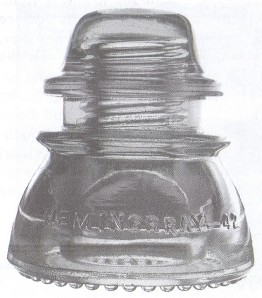
HEMINGRRAY - 42,
MADE IN U.S.A.
Round drip points
Blue Aqua
The piece had recently been purchased by Ben Cox, Austin, Texas, from N.R.
Woodward who had located several specimens while searching lines in Texas.
Another encouraging reason to check out each and every insulator for variations
-- even the
lowly Hemingray 42. You can clearly make out the two "R"s in
HEMINGRRAY.
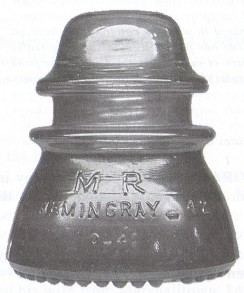
|
MR
HEMINGRAY - 42
0-4': |
MADE IN U.S.A.
20 C |
Round drip points |
Clear |
As elusive as they come, the MR mold is a highly sought-after CD 154 anomaly by Hemingray collectors. This train soot-laden clear Hemingray-42 was recently
purchased in an eBay auction for just over $600 which is the price guide range
for this unusual mold embossing. The significance of the "MR" marking
is unknown.
The 0-4 mold marking (which indicates an initial 1934 manufacture date using
this mold) has 3 dots added, one for each year after 1934 that the mold was
used. This particular "MR" was made in 1937, rear skirt 20 C for the
mold number.
Additional information from the seller of the insulator, Henry
Faugno of Paducah, Kentucky:
I had heard that a few of these insulators had turned up in New Jersey some
time ago, it is a coincidence that I am originally from N.J. but I have lived
here in Paducah, KY. for 40 years, and I have only had the insulator for a
couple of years, and as hard as I try I can't remember exactly where I ran
across it. I never placed much value on them, because I never collected or
researched them. Paducah is a river city (the Ohio and Tennessee Rivers) but for
close to one hundred years it was also a railroad town (I.C.R.R.) The ICRR built the
largest shops south of St. Louis here on some 14,000 acres, and at one time
employed 2,000 people... well a lot of those people have retired and of course
passed away, so for many years there have been lots of estate sales of these
peoples' belongings and collections of railroad memorabilia...so it is very
likely I could have picked it up at one of these auctions. It would have to have
been in with something else for I wouldn't have bid on it by itself (not knowing
anything about insulators). The only other place that I can think of was from an
87 year old man that I became friends with when he moved here from Chicago after
he retired from being with the ICRR in Chicago for 40 something years. He had a
large collection of model trains and RR memorabilia and I purchased his entire
collection a couple of years ago and it could have been mixed in with the
collection...I have no way to confirm this as my friend has passed away also. He
actually lived in southern Illinois, which is just across the Ohio River from
Paducah. So I believe the insulator came from this region. I guess they are not
only in N.J. I now understand how rare they are... but you never know do you? It
certainly helps to be informed about things though, but then again one can't
know everything. I am glad it has gone to someone who appreciates it and knows
what it is.
I have a "MR" HEMINGRAY in my collection, but my insulator was made
in 1936 in mold 36 A, so we know that the insulators were made over a period of
at least three years beginning in 1934. Just wonder why more have not been
located. Of course, you will all be checking those dirty, clear Hemingray-42s
with more diligence, won't you? Believe It Or Not!
HOLY HALEY!
An insulator that has maintained a very low profile for many years is a piece
that was designated as the "Haley" in the early Milholland reference
books. I had seen two of them over the years, but since the piece was made of
some kind of slag composition and had never been assigned a CD number, it was
not a piece that I had paid a lot of attention to during my serious collecting
days.
However, the year 2002 has already given me three reasons to think about
this piece, and who knows, maybe there will be more before the year ends.
As you know, the editor and I attended the Lawless wedding in January
(pictures in the March, 2002 CJ), and I had a chance to talk with Don Otis, a
long time insulator collector and friend that I haven't seen in several years.
Naturally the topic of insulators came up during the weekend, and at some point
Don said, "you knew that I picked the first Haley, didn't you?" Well,
as a matter of fact I didn't. Here's the story.
A fellow collector of Don's, not
surprisingly named Dave Haley, had spotted an unusual looking insulator mounted
on the side of a house in Rensselaer, NY in the late 60's. Dave apparently
didn't have the wherewithal to remove the piece, and Don did, so arrangements
were made to move the piece from its former location to Dave's collection.
Dave's piece is the one pictured in the early Milholland reference books and
credited to him. To the best of Don's knowledge, that first Haley still resides
in Dave's collection. I thought it was about time Don got the proper credit for
introducing this interesting piece to the hobby.
Well, I had just begun to recover from that historical revelation about the Haley when Mrs. Mac and I
hosted an insulator swap for the GCIC at our house in February, 2002. We
normally have 30-40 collectors show up with anywhere from 12-20
"tables" of sales items, and this swap was no exception. Several new
collectors came this year, including Dan Wolfe and his wife from Marshalltown,
IA. He had called to say that he was bringing an insulator that a bottle digger
friend of his had dug near his home. A small drama ensued as six or eight of us
were standing in the garage waiting and watching as Dan unwrapped his
"find." When he got to the last layer, a brown paper bag, it was clear
to me that he was going to show us an EC&M, and I was wondering what an
EC&M was doing buried in the middle of Iowa. Boy, was I surprised!!! Out
pops another Haley.
It had a two fair sized chunks missing from the skirt, but
otherwise it was in very nice condition. A discussion followed trying to put a
fair value on the piece, and a number of collectors expressed interest in
acquiring it, but that day was just a show and tell day for the new found Haley.
Believe It Or Not!- Who knows, that one may change hands later this year.
Speaking of changing
hands, a third Haley went up on the auction block in one of the hobby's catalog
sales this year. I think the seller and the buyer want to remain anonymous, but
suffice it to say that the piece moved from one outstanding collection to
another outstanding collection. I found it interesting that it's been nearly 20
years since I have heard mention of the Haley, and in 5 months, I was made
aware of stories or transactions involving 60% (that's 3 out of 5) of the known
examples of the Haley, Believe It or Not!
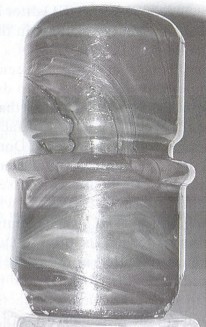
This specimen is a reddish brown color
with bands of blue gray swirling
through out.
The two chips are opposite one another at the base,
but still the
insulator displays pretty well.
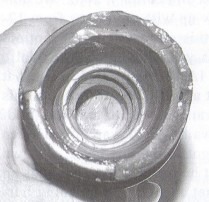
The uniquely threaded pinhole is a 3 to 1 pitch
which narrows at the top
rather than the standard
4 to 1 spiral. The insulator was made in a
three-piece
mold with the unusual circular
mold plate on the dome top.
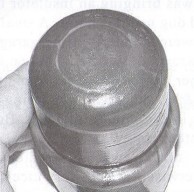
Now, for the rest of the story. . .
On Monday following the club swap meet, Mrs. Mac left for Washington, D.C.
where she was to join Larry Novak, Kevin Lawless, Ken Willick, Rick Soller and
Elton Gish at the annual N.I.A./Smithsonian Institution "marathon"
hosted by Nance Briscoe of the Department of Electricity.
Not knowing what the
given assignments might be for the group, Mrs. Mac was prepared to be put to
work doing whatever task the Smithsonian Institution needed accomplished. Nance
assigned Elton and Mrs. Mac to the mezzanine level of the museum which housed
bound trade journals, catalogues and periodicals. No one from the N.I.A. marathon
team had been given that particular assignment to date, and both Mrs. Mac and
Elton were anxious to see what the mezzanine contained.
It has been many years
since Mrs. Mac had been in "the stacks" of a research library. She was
impressed with the compressed rows of library shelving, the magic buttons that
could be pushed to spread the shelves, the weighted floor sensors that indicated
someone was between rows (so that another person couldn't push the magic button
elsewhere on the row avoiding flattening the researcher between shelves),
and the stacks of uncatalogued journals that needed processing.
After a quick
tour of the library, Nance left Elton and Mrs. Mac alone to explore. What a
challenge!
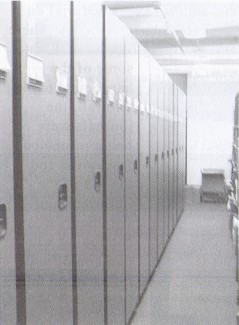
And, there was an emotional moment for Mrs. Mac when she pressed the
magic button on the "C" aisles and the shelves parted to reveal the
neatly and newly hardbound volumes of Crown Jewels of the Wire (a gift from J. Chester Gordon) which will
be available for research in years to come.
Elton Gish is one of the consummate navigators of reference libraries. Why, when you look up researcher in the
dictionary, Elton's picture is there! He was right at home, pulling journals off
the shelves and diving into them head-first to see what he might find pertinent
to insulators. Elton was hitting the trade journal hard, while Mrs. Mac decided
to look through a tall; bookshelf of uncatalogued items.
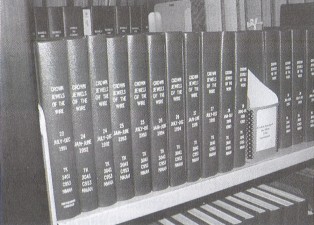
An hour of looking
at the beautiful lithography of the 19th century journals yielded nothing on
insulators but loads of material on everything from sewing machines to electric
dynamos. There didn't seem to be a lot of care in grouping like journals into
some of the hardbound books. After all, the journals were being protected from
wear and the job of the librarians and volunteers was cataloging where you could
find information on "x - y -z".
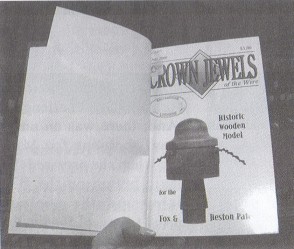
Last row of uncatalogued material, next to last hardbound book.. . a catalog
of farm equipment, sewing machines for ladies, more farm equipment, catalogue of
telegraph material and electrical apparatus. Bingo! There is was, the last
journal bound in that book -- an 1873 catalogue of telegraph material and
electrical apparatus manufactured by Charles T. Chester, No. 104 Centre Street,
New York.
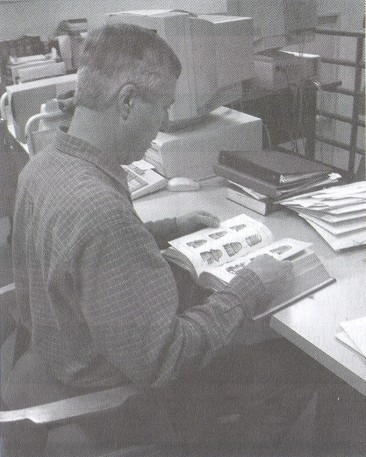
Mrs. Mac was ready to burst! She carefully opened the cover. There on
page 32 was an incredible lithograph depicting oak brackets, glass insulators,
Brooks' Patent parafine insulators and. . .
the Haley!!!
"E-L-T-O-N!!!"
You should have seen the "high five" dance Mrs. Mac and Elton did on the mezzanine floor of the Smithsonian Institution! So, within a
span of 6 days, a Haley had been brought to our home in Illinois and Mrs. Mac
had found a catalogue which shed light on its manufacturer / distributor in
1873.
Now, that is a Believe It Or Not! story.
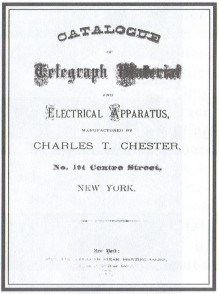
Armed, with the 1873 Chester
catalog found at the Smithsonian Institution and photos taken of the recently
dug specimen in Iowa, we may have information in coming months as to whether or
not the "Haley" receives a new CD or U- number.
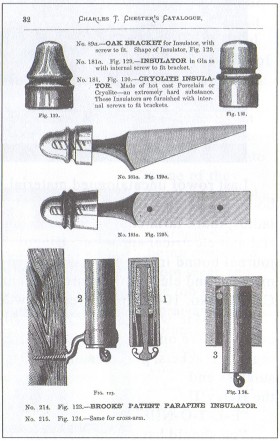
It will all probably
will boil down to whether or not cryolite is porcelain or glass.
Maybe a chemist
can enlighten us as to the composition of cryolite.
Believe It Or Not!
| 